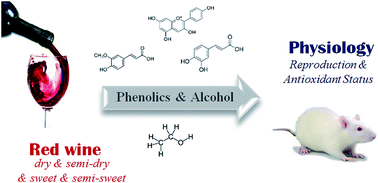The effect of red wine consumption on hormonal reproductive parameters and total antioxidant status in young adult male rats
Abstract
Very little is known about the effects of red wine consumption on male reproductive functions. Here we report the effect of regular drinking of different types of red wine on hormonal reproductive parameters and total antioxidant status in young adult male rats. Dry red wine (D-RW) exerted higher antioxidant activity and was characterized by higher concentration of phenolic compounds compared to semi-dry (SD-RW), sweet (S-RW) and semi-sweet (SS-RW) wines. No differences in total antioxidant status of rat plasma after six weeks of drinking of the wines were detected. Increased plasma follicle-stimulating hormone levels in S-RW versus control and D-RW (5.26 vs. 3.06 and 3.21 ng mL−1) groups were found. The plasma testosterone concentration was lower in D-RW compared to control, SD-RW, S-RW and SS-RW groups (0.25 vs. 1.12, 1.09, 1.54 and 1.25 ng mL−1). Higher plasma 17β-estradiol level in S-RW versus SD-RW and SS-RW (10.94 vs. 7.18 and 6.72 pg mL−1) group was stated. The prolactin level was higher in plasma of S-RW versus D-RW and SS-RW (17.35 vs. 9.74 and 8.59 ng mL−1) rats. The effects of red wine drinking on the hormonal regulation of the male reproductive system depend on the type and the dose of red wine. Chemical compounds naturally occurring in red wines (i.e. phenolics) may modulate the effects of ethyl alcohol, but also directly affect the male reproduction.


 Please wait while we load your content...
Please wait while we load your content...